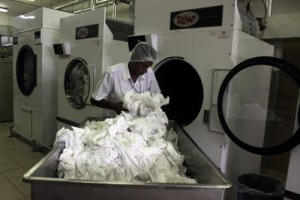Serving the best meal on-board, a challenge every airline faces
One of the common issues airlines face is the quality of food served on-board whether it is in economy, first or business class. Airlines take a massive risk in serving the best food on board as it reaches 35,000 feet from ground under extreme environmental conditions. Due to pressure variations and variations of taste buds of passengers, the food served on-board tastes different than when it’s served on ground.

File picture of the laundry
SriLankan Airlines, the country’s national carrier took the media on a tour to explore the SriLankan Catering at Katunayake recently. It is located almost a kilometre away from the airport and meals to the flight are transported in lorries to the aircraft. SriLankan Catering CEO Sarath Fernando speaking at the briefing held at the Catering boardroom said, “SriLankan Airlines is the only airline which has four varieties of meals for Business Class passengers and three in Economy Class. SriLankan Catering is the largest kitchen in the country which has a production of over 20,000 meals per day with a maximum capacity of 25,000 meals per day. 70 per cent of the meals are served to SriLankan Airlines and the balance 30 per cent to 10 other airlines that arrive in Sri Lanka.”
He also noted that five years ago SriLankan Catering used 30 per cent of local products whilst the rest is imported, but today there is a huge turnover with 80 per cent local products and the rest imported. After every quarter the menu is changed depending on the customer requirement, added Mr. Fernando.
Initially the media was taken down to the level where the raw materials arrive at SriLankan Catering. There food is stored in massive chillers with required very low temperatures. There were vegetables, fruits and meat stored for more than three months. Dry rations and dairy products are also stored for some time depending on the expiry dates. Each airline has its own menu, cutlery and glass ware where everything is separately stored without getting mixed.

Pic courtesy srilankan.com
A SriLankan laundry service is available where the uniforms of staff, bed sheets, neck rests and napkins once used in an aircraft are washed and dried before they are used again. There is also a tailoring department to sew torn sheets and clothes.
There is also a laboratory at the Catering to check the hygiene of a meal that is served on board before the meal is taken to the aircraft. Also any complaints regarding the meals are taken to the laboratory for inspection. There are two kitchens, mainly the hot kitchen and the cold kitchen. In the hot kitchen food is cooked in large containers and sent into the chillers where the temperature drops from 80 degrees to 5 degrees. Then the food is taken out from the chillers and portioned into small containers and put back into the chillers again.
Then the meal packs are loaded into carts which again will be loaded into the aircraft. Inside the aircraft the meal is heated once again before it goes to the passenger by the cabin crew.
The meal that is prepared on ground should reach the passenger before 72 hours from the time it’s cooked.


